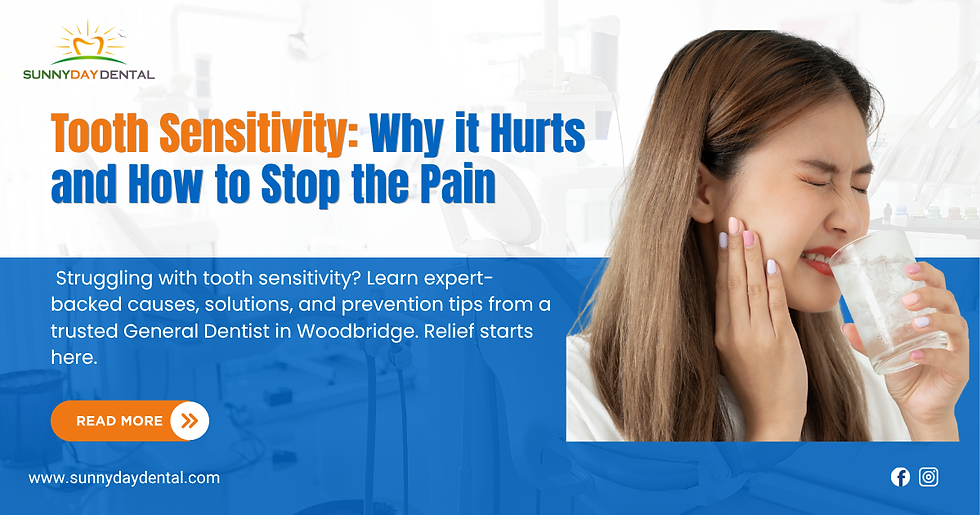What Counts as a Dental Emergency? 5 Signs You Need Immediate Care
- Sunny Day Dental
- Jun 2
- 3 min read

Dental issues can sometimes wait, but when it comes to a dental emergency, every second matters. From severe tooth pain to a knocked-out tooth, recognizing the signs early can be the difference between saving or losing a tooth, avoiding infection, and reducing long-term treatment costs. Let’s walk through what truly qualifies as a dental emergency and what you should do next.
What Is Considered a Dental Emergency?
A dental emergency refers to any oral health issue that requires immediate treatment to stop bleeding, alleviate extreme pain, save a tooth, or treat an infection. Common signs include intense pain, broken or dislodged teeth, swelling, and bleeding.
1. Severe Tooth Pain That Won’t Go Away
Toothaches can stem from various causes, but if you're experiencing severe tooth pain that disrupts your sleep, eating, or daily routine, it’s a red flag. This pain may indicate an exposed nerve, deep decay, or infection. You shouldn’t delay, as untreated infections can spread to other parts of the body.
What to do: Rinse your mouth with warm water, avoid hot or cold foods, and contact an emergency dentist immediately. Opting for emergency dentistry in Woodbridge ensures you get expert care close to home.
2. Knocked-Out Tooth
A knocked-out tooth due to trauma is one of the most urgent dental emergencies. Time is critical—if you get professional help within 30 to 60 minutes, the tooth can often be re-implanted successfully.
What to do:
Pick up the tooth by the crown (not the root).
Rinse it gently with water if dirty.
Try to place it back in the socket, or store it in milk.
Seek emergency dentistry in Woodbridge without delay.
3. Abscess or Swelling in the Gums
A dental abscess is a pus-filled infection usually caused by untreated cavities, gum disease, or trauma. Symptoms include swelling, fever, bad breath, or a pimple-like bump on the gums. This is a dangerous dental emergency that can spread quickly to the jaw, neck, or even brain if ignored.
What to do: Rinse with salt water, avoid pressure on the affected area, and visit your dentist ASAP.
4. Broken or Cracked Tooth with Pain
Not all chipped teeth require emergency care. However, if a tooth is fractured and causing pain or exposing nerves, it becomes a dental emergency. Left untreated, it can lead to infection or tooth loss.
What to do: Avoid chewing on that side, keep the area clean, and seek help. Quick treatment can prevent complications and restore the tooth.
5. Uncontrollable Bleeding After Dental Work or Injury
Some bleeding after procedures like tooth extraction is normal. But if it continues for more than a few hours or is heavy, it could be a dental emergency. Excessive bleeding might indicate a clotting disorder or trauma to deeper oral tissues.
What to do: Bite on gauze firmly, avoid rinsing, and go to an emergency dental clinic immediately.
When to Seek an Emergency Dentist Near Me
If you’re searching for an emergency dentist near me, it likely means you’re experiencing pain or worry that needs immediate attention. Don’t hesitate. Timely care protects your smile and your overall health.
Final Thoughts
Understanding what qualifies as a dental emergency can save you time, money, and pain. Whether it’s severe tooth pain, a knocked-out tooth, or sudden swelling, your best bet is to act quickly. Choose a trusted clinic like Sunny Day Dental for responsive, compassionate, and effective treatment.
Need Help Right Now?
If you’re experiencing any signs of a dental emergency, Sunny Day Dental in Woodbridge is here to help. Our experienced team offers same-day appointments and compassionate care tailored to your needs.
FAQs
1. Can I go to the ER for a dental emergency?
Yes, especially if the pain is unbearable, there’s excessive bleeding, or facial swelling is spreading. However, for direct treatment of tooth issues, visiting a dental clinic is usually more effective and faster.
2. Is a broken dental crown considered an emergency?
If the broken crown is causing pain or exposes sensitive areas of the tooth, it is a dental emergency. Otherwise, you can schedule a regular dental visit within a few days.
3. How can I manage dental pain before seeing a dentist?
Use over-the-counter pain relievers, apply a cold compress to the cheek, and rinse with salt water. These methods can help reduce inflammation temporarily but are not substitutes for proper treatment.
4. What happens if I ignore a dental emergency?
Ignoring a dental emergency can lead to infections, tooth loss, systemic health problems, and even hospitalizations in severe cases. Immediate attention ensures better outcomes.
5. Are emergency dental visits covered by insurance?
Many dental insurance plans cover emergency dentistry in Woodbridge, especially for trauma, infection, or urgent procedures. Always check with your provider for details.




Commentaires